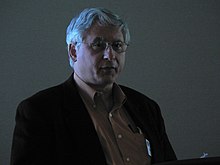Paul DiMaggio

Paul Joseph DiMaggio(born January 10, 1951, inPhiladelphia,Pennsylvania)[1]is an American educator, andprofessorofsociologyatNew York Universitysince 2015. Previously, he was a professor of sociology atPrinceton University.
Biography
[edit]A graduate ofSwarthmore College,DiMaggio earned hisPh.D.in sociology fromHarvardin 1979. He was the executive director ofYale'sprogram on nonprofit organizations (1982–87), and through 1991 he was a professor in the sociology department at the university. He was a fellow at theCenter for Advanced Study in the Behavioral Sciences(1984–85) and at theJohn Simon Guggenheim Memorial Foundation(1990). He also served on theConnecticutCommission on the Arts and on the board of the National Assembly of State Arts Agencies. He was elected to theAmerican Philosophical Societyin 2016.[2]
Work
[edit]DiMaggio's major works have been in the study of institutions and organizations and the formation of "high culture" in the U.S. His recent research exploressocial inequalityin the Internet.
According to DiMaggio, belief systems and cultural frames are imposed on and adapted by individual actors and organisations. Thus, roles are for a large part determined by larger structures.
In a much-quoted article, DiMaggio andWalter W. Powellargued that organizations, whether corporate, governmental, or non-profit, adopt business practices not because they are efficient, but because they furnish legitimacy in the eyes of outside stakeholders, e. g. lenders, government regulators, and shareholders, as they need to maintain the confidence of these often poorly-informed outside parties. This makes them less creative and innovative in their practices, and leads toinstitutional isomorphism.
In his cultural studies, DiMaggio's historical research documented the self-conscious creation of "high culture" in the late 19th-century America. DiMaggio argues that, unsettled by the weakclassdistinctions in growingindustrialcities, localelitescreated a "sophisticated" culture (via thearts,universities,social clubs,and the like) that would separate commoners from those of high standing. DiMaggio says that "high culture" models developed by founders ofmuseumsandorchestraswere then adopted by patrons ofopera,dance,andtheatre.
DiMaggio's recent research considers the cultural advent of the Internet. He compares the emergence of the Internet with the rise oftelevisionin the 1950s.[3]Television was introduced to Americanconsumersin 1948, and within ten years 90% ofhouseholdshad TV. In contrast, Internet diffusion (introduced on a large scale in 1994) seems to have stalled at approximately 60% of American households. DiMaggio believes that this difference is the result of the so-calleddigital divide- inequalities in Internet usage byrace,income,andeducationlevel. DiMaggio maintains that these inequalities were not found in the adoption of TV in the 1950s, and suggests that differences in Internet usage among social groups will continue. This remains an open question, and some recent data suggest Internet usage is growing, with more than 70% of American adults reporting that they use the Internet.[4][5][6]
Selected bibliography
[edit]- The Twenty-First Century Firm: Changing Economic Organization in International Perspective(editor), Princeton University Press 2001ISBN0-691-11631-8
- Race, Ethnicity, and Participation in the Artswith Francie Ostrower, Seven Locks Press 1992ISBN0-929765-03-6
- The New Institutionalism in Organizational Analysis(editor with Walter Powell), University of Chicago Press 1991ISBN0-226-67709-5
- Managers of the Arts,Seven Locks Press 1988ISBN0-932020-50-X
- Nonprofit Enterprise in the Arts: Studies in Mission and Constraint(editor), Oxford University Press 1987ISBN0-19-504063-5
- "The Iron Cage Revisited: Institutional Isomorphism and Collective Rationality in Organizational Fields,” inAmerican Sociological Review48:147-160, 1983. (With Walter W. Powell).
References
[edit]- ^"DiMaggio's CV"(PDF).http://wagner.nyu.edu/dimaggio.RetrievedFebruary 26,2008.
{{cite web}}:External link in|work= - ^"APS Member History".search.amphilsoc.org.RetrievedFebruary 18,2021.
- ^Paul J. DiMaggio and Joseph Nathan Cohen (2005) "Information Inequality and Network Externalities: A Comparative Study in the Diffusion of Television and the Internet" in Richard Swedberg andVictor Nee(eds.)The Economic Sociology of Capitalism(Princeton: Princeton University Press): 227 - 267.
- ^"Reports: Internet Evolution".Pew/Internet. April 25, 2006. Archived fromthe originalon September 9, 2007.RetrievedSeptember 10,2007.
- ^"From Unequal Access to Differentiated Use"(PDF).(293KiB)
- ^"From the 'Digital Divide' to 'Digital Inequality'"(PDF).(237KiB)
External links
[edit]
